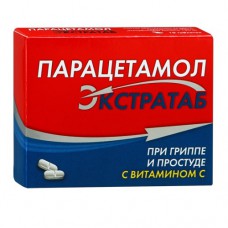Expiration date: 04/2025
Composition per 1 tablet:
active ingredients-paracetamol-0.5 g; ascorbic acid-0.15 g
excipients: hydroxypropylmethylcellulose (hypromellose), polyethylene glycol 6000 (macrogol 6000), corn starch, stearic acid.
Pharmacological action
Analgesic-antipyretic. It has analgesic, antipyretic and weak anti-inflammatory effect. The mechanism of action is associated with the inhibition of prostaglandin synthesis, the predominant effect on the center of thermoregulation in the hypothalamus.
Indications for use
Pain syndrome of mild and moderate intensity of different Genesis (including headache, migraine, toothache, neuralgia, myalgia, algomenorrhea; pain in trauma, burns). Fever in infectious and inflammatory diseases.
Contraindications to the use of the drug
Hypersensitivity, severe hepatic and renal impairment, genetic lack of glucose?6-phosphate dehydrogenase, blood diseases; urolithiasis, if the dose of vitamin C exceeds 1 g/day .Chronic active alcoholism, increased sensitivity to paracetamol.
Use of the drug during pregnancy and feeding
Paracetamol penetrates through the placental barrier. To date, no negative effects of paracetamol on the fetus in humans have been observed.
Paracetamol is excreted in breast milk: the content of milk is 0.04-0.23% of the dose taken by the mother.
If necessary, the use of paracetamol during pregnancy and lactation (breastfeeding) should be carefully weighed the expected benefits of therapy for the mother and the potential risk to the fetus or child.
In experimental studies, no embryotoxic, teratogenic and mutagenic action of paracetamol was established.
Application in violation of liver function
With caution used in patients with impaired liver function.
Use in renal impairment
With caution used in patients with impaired renal function.
Side effect
From the digestive system: rarely-dyspeptic phenomena, with prolonged use in high doses-hepatotoxic effect.
From the hematopoietic system: rarely-thrombocytopenia, leukopenia, pancytopenia, neutropenia, agranulocytosis.
Allergic reactions: rarely - skin rash, itching, urticaria.
Drug interaction
While the use of inducers of microsomal liver enzymes, means, having hepatotoxic effect, there is a risk of increasing the hepatotoxic action of paracetamol.
While the use of anticoagulants may be a small or moderate increase in prothrombin time.
While the use of anticholinergics may reduce the absorption of paracetamol.
While the use of oral contraceptives accelerates the excretion of paracetamol from the body and may reduce its analgesic effect.
While the use of uricosuric agents decreases their effectiveness.
While the use of activated carbon reduces the bioavailability of paracetamol.
When applied simultaneously with diazepam may decrease excretion of diazepam.
There are reports of the possibility of increasing the myelodepressive effect of zidovudine while using paracetamol. The case of severe toxic damage to the liver is described.
Cases of manifestations of the toxic effect of paracetamol with simultaneous use with isoniazide are described.
While the use of carbamazepine, phenytoin, phenobarbital, primidone decreases the effectiveness of paracetamol, due to an increase in its metabolism (glucuronidation and oxidation) and excretion from the body. Cases of hepatotoxicity with simultaneous use of paracetamol and phenobarbital are described.
When using colestyramine for a period of less than 1 h after receiving paracetamol may reduce the absorption of the latter.
While the use of lamotrigine moderately increases the excretion of lamotrigine from the body.
While the use of metoclopramide may increase the absorption of paracetamol and increase its concentration in blood plasma.
With simultaneous use with probenecid may decrease clearance of paracetamol with rifampicin, sulfinpirazon - may increase clearance of acetaminophen by increasing its metabolism in the liver.
While the use of ethinyl estradiol increases the absorption of paracetamol from the intestine.
Dosage regimen
Adults and children over 12 years (weighing more than 50 kg) to take 1 tablet 3-4 times a day with an interval between doses of 4-8 hours. Children from 6 to 12 years-1/2 tablet, the maximum daily dose - 2 tablets.
The maximum duration of treatment for children is 3 days.
The maximum duration of treatment for adults - no more than 5 days when administered as an anesthetic and no more than 3 days-as a antipyretic.
Overdose
When using high doses of the drug in patients there is a development of nausea, vomiting, digestive disorders. When using the drug in doses much higher than the recommended possible development of hepatotoxic and nephrotoxic effects of the drug, in addition, it is possible to develop metabolic acidosis, encephalopathy, coma and death. In case of overdose, gastric lavage and enterosorbents intake is indicated (if no more than 2 hours have passed after taking the drug). If necessary, conduct symptomatic therapy. In severe poisoning with paracetamol, parenteral administration of acetylcysteine and methionine is indicated. In case of severe overdose, hospitalization is necessary.
Special instruction
With caution used in patients with impaired liver and kidney function, with benign hyperbilirubinemia, as well as in elderly patients.
With long-term use of paracetamol, it is necessary to control the picture of peripheral blood and the functional state of the liver.
It is used to treat premenstrual tension in combination with pamabrom (diuretic, xanthine derivative) and mepyramine (the blocker of histamine H1-receptors).


